Objectives and Goals:
(a) Mineral, Ore.
(b) Importance of minerals.
(c) Properties of minerals.
(d) Classification of minerals (i.e. Metallic, Non-Metallic and Mineral Fuels).
(e) Where are these minerals found?
(f) How the minerals are extracted by Mining, Drilling and Quarrying.
(g) Ferrous Minerals (Iron Ore and Manganese).
(h) Non-Ferrous Minerals (Copper and Bauxite).
(i) Non-Metallic Minerals (Mica and Limestone).
(j) Conservation of minerals.
(k) Hazards of Mining.
(l) Energy Resources (i.e. Conventional and Non-Conventional resources).
(m) Conventional resources of energy (i.e. Coal, Petroleum, Natural Gas and Electricity: both
Hydro and Thermal).
(n) Non-Conventional resources (i.e. Nuclear Atomic Energy, Solar, Wind, Biogas, Tidal, and Geo Thermal).
(o) Conservation of Energy Resources).
• Earth crust is made up of different metals, which are extracted from minerals.
• Almost everything is made of minerals.
Q. What are minerals?
Ans: Homogenous naturally occurring substance with a definite internal structure is known as a mineral.
Minerals are formed in different types of geological environment, under varying conditions. They are created by natural process without any human interference. They can be identified on the basis of their physical properties such as colour, density, hardness and chemical property such as solubility.
Q. What is an ORE?
Ans: An ore is a rock deposit that contains enough mineral to make it economically feasible to extract and purify to derive a desired product material. Typical ores and their desired material extracted are: Magnetite - Iron, Bauxite - Aluminium, Limestone - Lime, Sandstone - Silica.
IMPORTANCE OF MINERALS:
(a) Minerals are used in industries. It is the backbone of industrial development.
(b) Minerals are used for making tools, implements, machines, etc.
(c) Minerals are used in the manufacturing of jewellery, coins, utensils, decorative items, etc.
(d) Minerals are used for construction work.
(e) Minerals are used for health purpose.
In short, Minerals are used in almost every form of life to lead a happy and comfortable life.
PROPERTIES OF MINERALS:
(a) Minerals are non-renewable 'exhaustible' resources.
(b) Minerals take millions of year to form and are present in impure form.
(c) Minerals are unevenly distributed throughout the world.
TYPES OF MINERALS
Over 2000 minerals have been identified and only a few have been abundantly found. On the basis of composition, minerals are classified as:
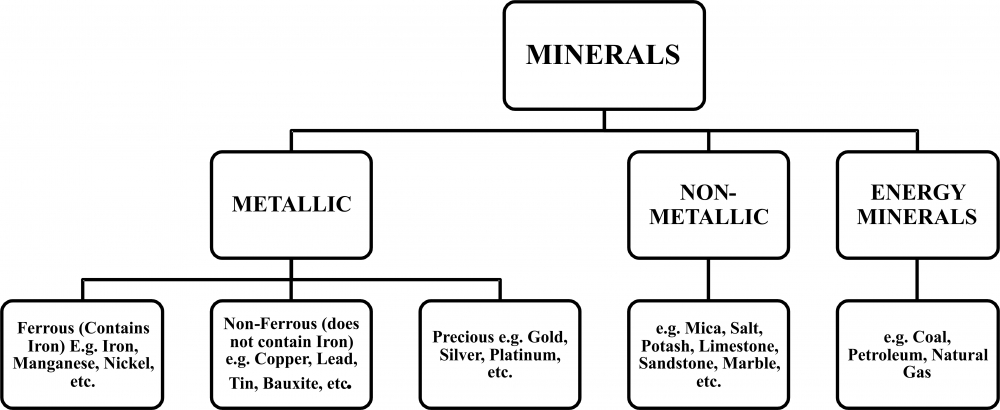
Q. How are minerals extracted?
Ans: Minerals can be extracted by Mining, Drilling and Quarrying.
(a) Mining: The process of taking out minerals from rocks buried under the earth's surface is called mining.
(i) Open Cast Mining: Minerals that lie at shallow depths are taken out by removing the surface layer is known as "Open Cast Mining".
(ii) Shaft Mining: Deep bores, called shafts, have to be made to reach mineral deposits that lie at great depth, this is known as "Shaft Mining".
(b) Drilling: Petroleum and natural gas occur far below the earth's surface. Deep wells are bored to take them out, this is called "Drilling".
(c) Quarrying: Minerals that lie near the earth's surface are simply dug out by the process known as "Quarrying".
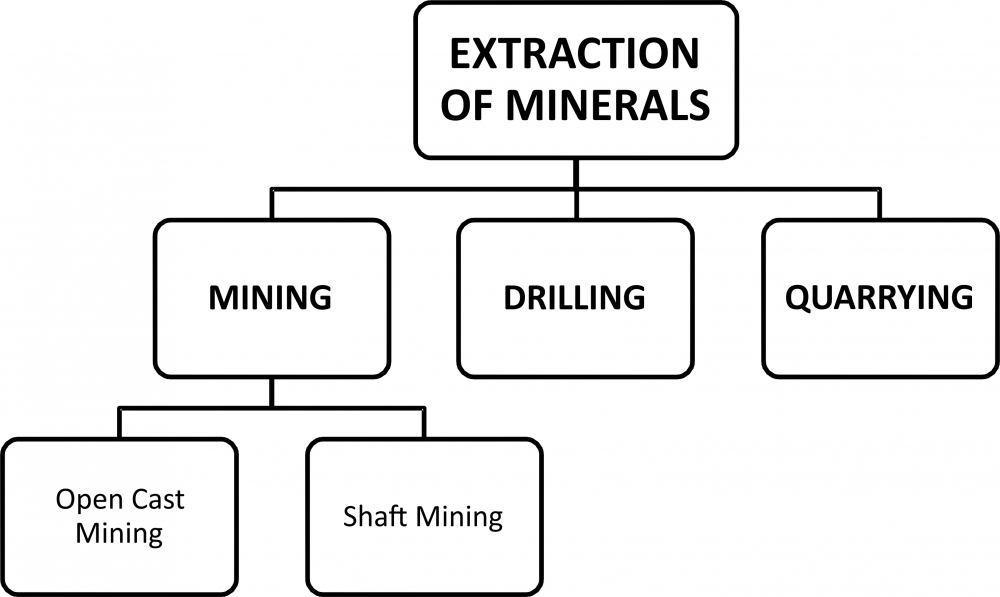
MODE OF OCCURRENCE OF MINERALS:
Q. Where are these minerals found?
Ans: Minerals are found in the following places:
1. In igneous and metamorphic rocks: The smaller occurrences are called veins and the larger occurrences are called lodes. They are usually formed when minerals in liquid/molten and gaseous forms are forced upwards through cavities towards the earth's surface. Examples: tin, copper, zinc, lead, etc.
2. In sedimentary rocks: In these rocks, minerals occur in beds or layers. Coal, iron ore, gypsum, potash salt and sodium salt are the minerals found in sedimentary rocks.
3. By decomposition of surface rocks: Decomposition of surface rocks and removal of soluble constituents leaves a residual mass of weathered material which contains ores. Bauxite is formed in this way.
4. As alluvial deposits: These minerals are found in sands of valley floors and the base of hills. These deposits are called placer deposits. They generally contain those minerals which are not corroded by water. Examples; gold, silver, tin, platinum, etc.
5. In ocean water: Most of the minerals in ocean water are too widely diffused to be of economic importance. But common salt, magnesium and bromine are mainly derived from ocean waters.
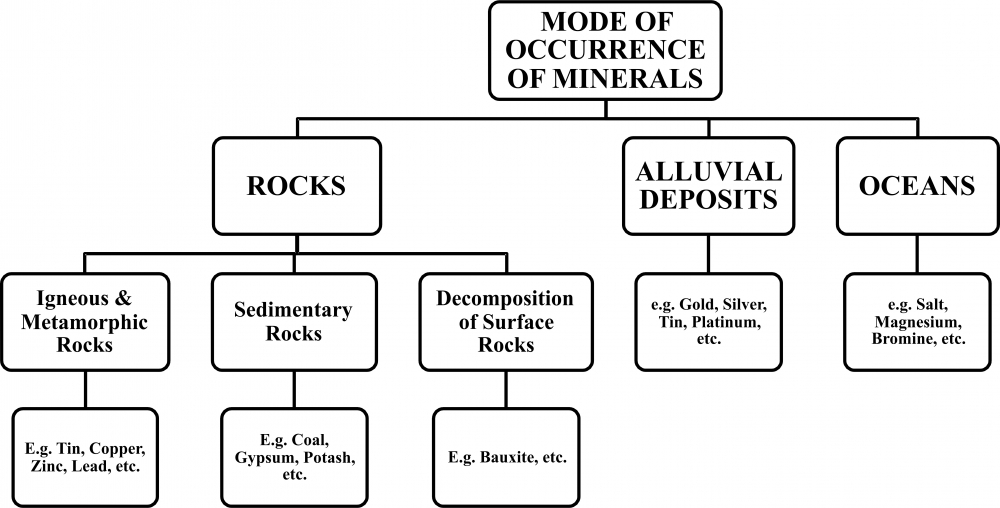
DISTRIBUTION OF MINERALS IN INDIA
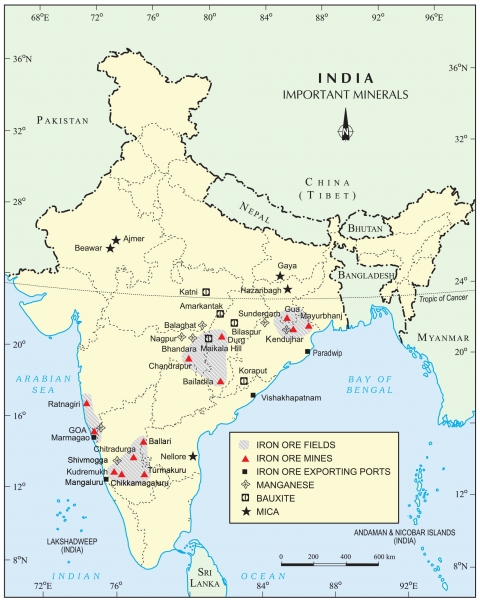
Ferrous Minerals:
• Ferrous minerals accounts for about three-fourth of the total value of production of the metallic minerals.
• Provide strong base for the development of the metallurgical industry.
• India exports good quantity of ferrous minerals.
IRON ORE:
• Iron ore is the basic mineral and is the backbone of industrial development.
• India is rich in good quality iron ores.
• Magnetite is the finest iron ore with a very high content of iron upto 70%. It has excellent magnetic properties because of which it becomes very valuable for the electrical industry.
• Hematite ore is the most important industrial iron ore; in terms of quantity usage. The iron content of hematite is 50-60%.
Major Iron Ore Belts in India:
1. Orissa Jharkhand Belt: Badampahar mines in the Mayurbhanj and Kendujhar districts of Orissa have high grade hematite ore. Additionally, hematite iron ore is mined in Gua and Noamundi in Singhbhum district of Jharkhand.
2. Durg Bastar Chandrapur Belt: This belt lies in Chhattisgarh and Maharashtra. The Bailadila range of hills in the Bastar district of Chhattisgarh have very high grade hematite ore. This hilly range has 14 deposits of super high grade hematite ore. Iron from these mines is exported to Japan and South Korea via Vishakapatnam port.
3. Bellary Chitradurga Chikmaglur Tumkur Belt: This belt lies in Karnataka. The Kudremukh mines located in the Western Ghats are a 100 percent export unit. The ore from these mines is transported as slurry through a pipeline to a port near Mangalore.
4. Maharashtra Goa Belt: This belt includes the state of Goa and Ratnagiri district of Maharashtra. The ores in these mines are not of very high quality. They are exported through Marmagao port.
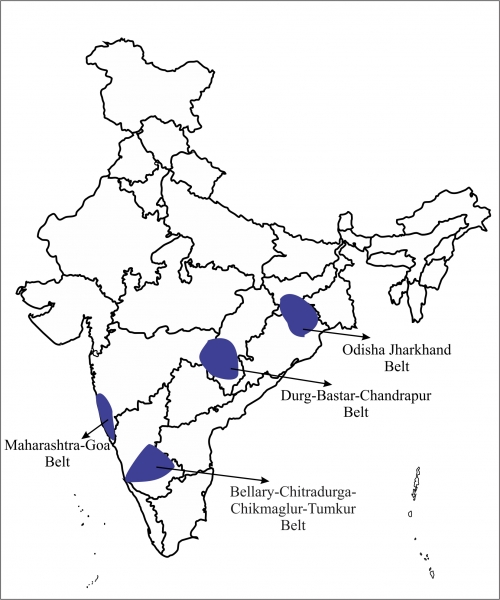
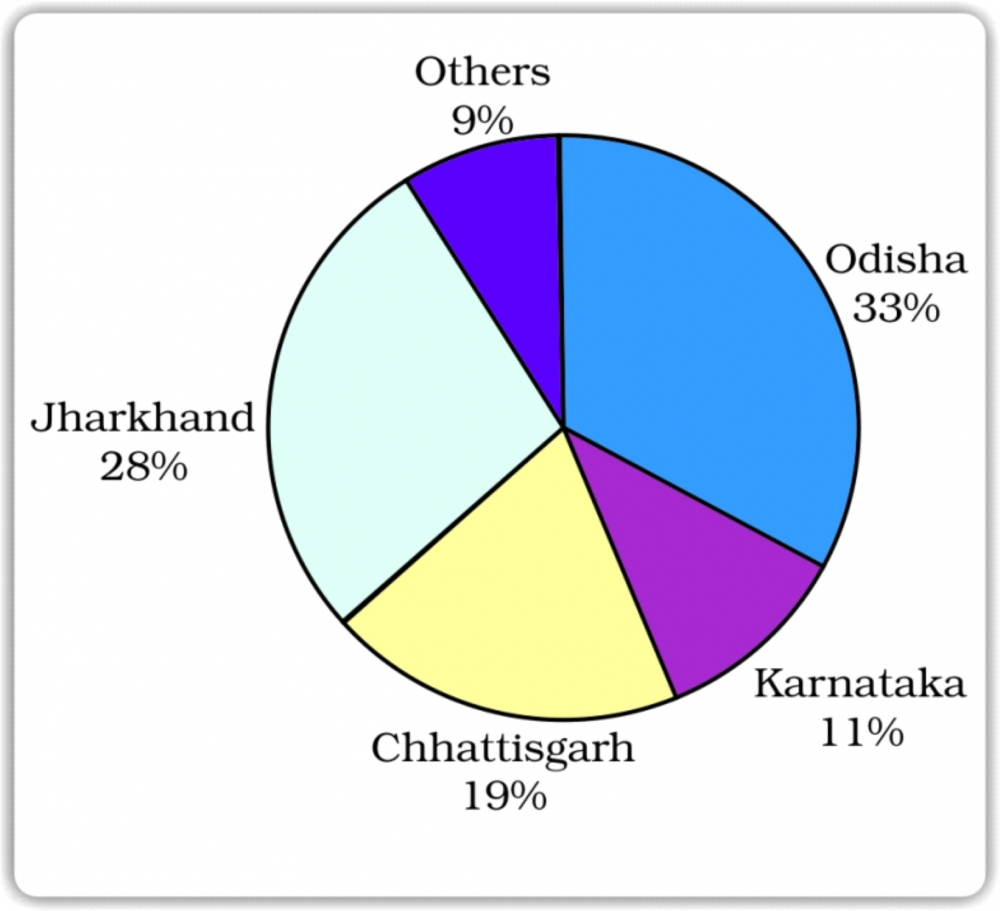
MANGANESE:
(a) Manganese is mainly used in the manufacturing of steel and ferro-manganese alloy.
(b) Nearly 10 kg of manganese is required to manufacture one tonne of steel.
(c) It is also used in manufacturing bleaching powder, insecticides and paints.
(d) Odisha is the largest producer of manganese ores in India. It accounted for one-third of the country's total production in 2000-01.
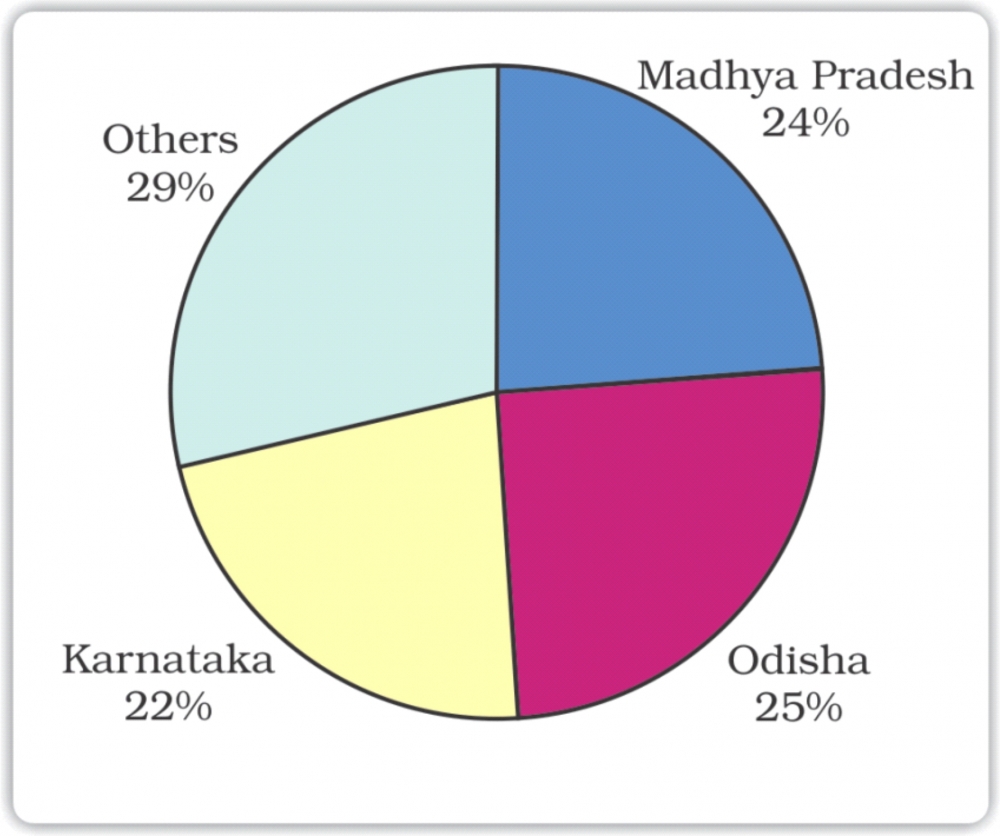
NON-FERROUS MINERALS:
(a) Availability of Non-Ferrous minerals in India is NOT of satisfactory level.
(b) E.g. Copper, Bauxite, Lead, Zinc, Gold, etc.
(c) These minerals play a vital role in a number of metallurgical, engineering and electrical industries.
COPPER:
(a) Copper is mainly used in electrical cables, electronics and chemical industries.
(b) Copper is a good conductor of electricity.
(c) India doesn't have good reserves of copper.
(d) Leading producers of copper in India are:
1. Khetri mines of Rajasthan.
2. The Balaghat mines in Madhya Pradesh.
3. Singhbhum district of Jharkhand.
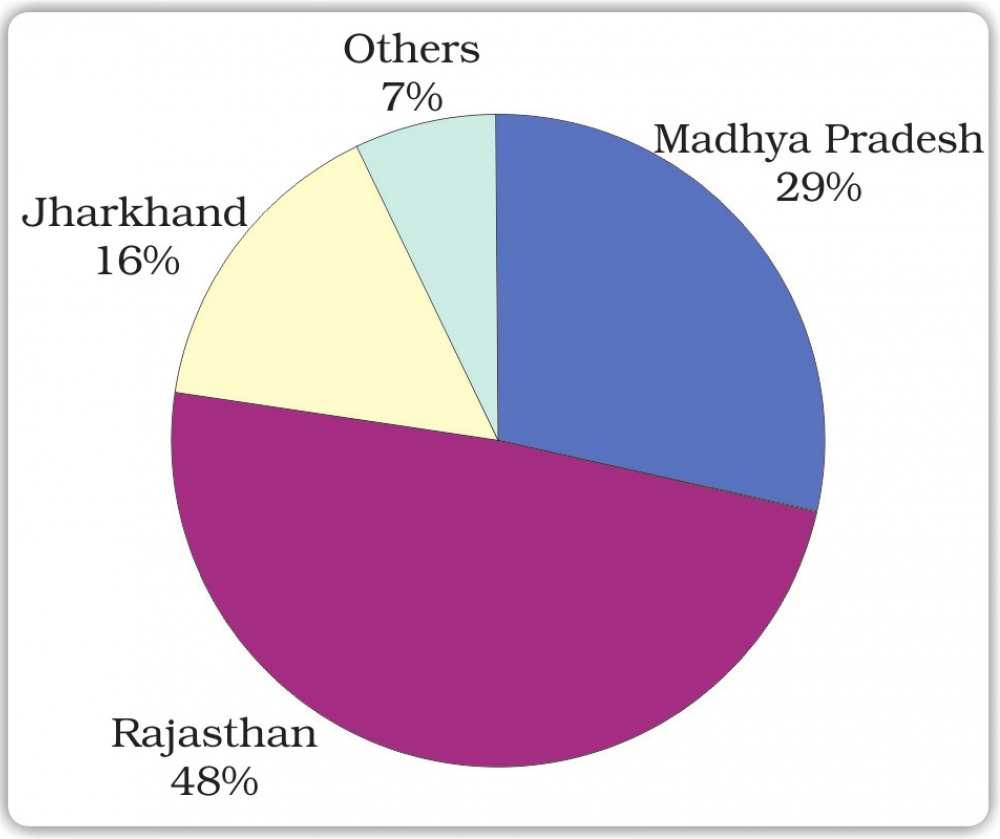
BAUXITE:
(a) Bauxite is clay like substance, out of which aluminum is obtained.
(b) Aluminum is incredibly popular because it is Lightweight, Strong, Durable, Ductile, Malleable, etc.
(c) Amarkantak Plateau, Maikal hills and the plateau region of Bilaspur-Katni are the main areas of bauxite deposits.
(d) In 2009-10 Orissa was the largest producer of bauxite in India with 34.97%.
(e) Panchpatmali in Koraput district is the most important centre of bauxite deposit in Orissa.
(f) Aluminum is used in: Automobiles, Aircraft, Spacecraft, Packaging (Cans, Foil, frame). Food and beverage containers, etc.
NON-METALLIC MINERALS
MICA:
(a) Mica is a mineral which is made up of a series of plates or leaves.
(b) The mica sheets can be so thin that a thousand of them can be layered into a few centimetre thick mica sheet.
(c) Mica has excellent di-electric strength, low power loss factor, insulating properties and resistance to high voltage.
(d) Mica is widely used in electric and electronic industries.
(e) Mica deposits are found in the northern edge of the Chota Nagpur plateau.
(f) Koderma-Gaya-Hazaribagh belt of Jharkhand is the leading producer of mica.
(g) Ajmer in Rajasthan and Nellore in Andhra Pradesh are the other important producers of mica.
ROCK MINERALS
LIME STONE:
(a) Lime stone is found in sedimentary rocks of most geological formations.
(b) It is found in association of rocks composed of calcium carbonates or calcium and magnesium carbonates.
(c) It is the base raw material for the cement industry.
(d) It is also used for smelting of iron ore in the blast furnace.
(e) Major producers of Limestone in India are: Karnataka , Andhra Pradesh, Madhya Pradesh, Chhattisgarh, Rajasthan and Gujarat .
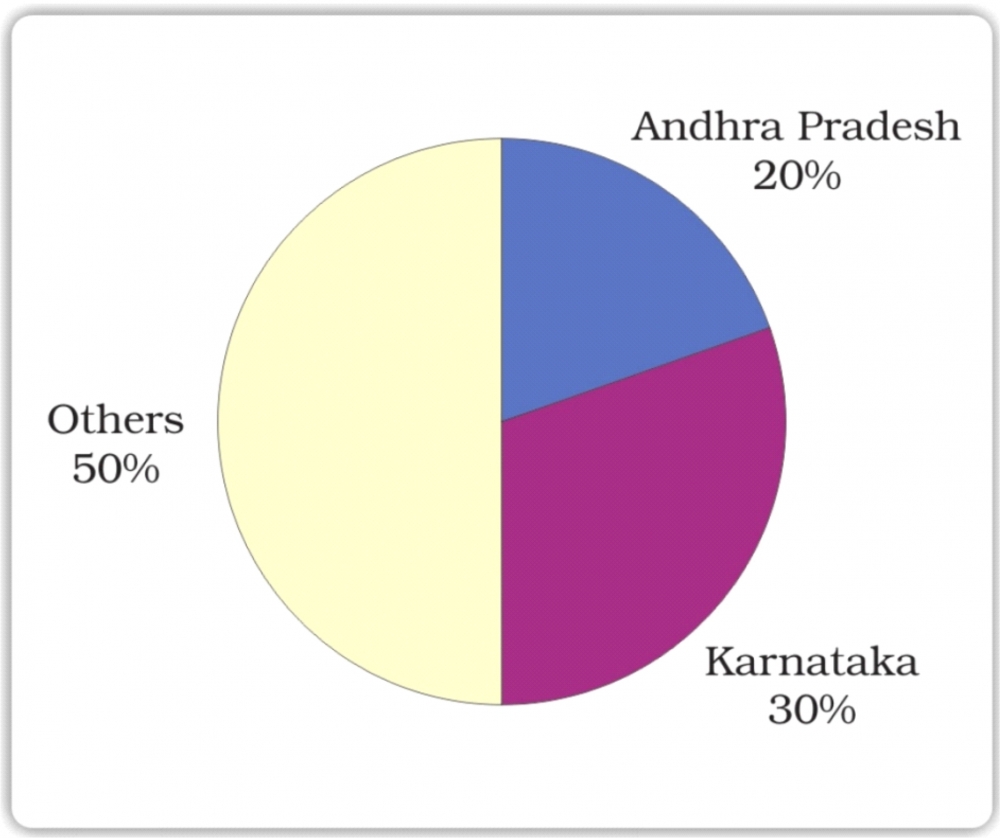
HAZARDS OF MINING
(a) Mining is a hzaradous industry; both for the workers and for the residents.
(b) The Miners have to work under tough conditions where no natural light is available.
(c) There is always a risk of collapse of mine roof, inundation with water and fire.
(d) The areas around mines face the problem of too much dust from the mines.
(e) Slurry from mines damages the roads and the farmland.
(f) Houses and clothes become dirty more often than in other areas.
(g) Miners are at great risk of getting afflicted with pulmonary disorders.
(h) Cases of respiratory tract diseases are very high in mining areas.
CONSERVATION OF MINERALS
(a) It takes millions of years for the formation of minerals.
(b) Compared to the present rate of consumption, the replenishment rate of minerals is very slow.
(c) Hence, mineral resources are finite and non-renewable.
(d) Due to this, it is important that we conserve the mineral resources.
(e) Minerals are a non-renewable resource.
(f) It takes thousands of years for the formation and concentration of minerals.
(g) The rate of formation is much smaller than the rate at which the humans consume these minerals. It is necessary to reduce wastage in the process of mining.
(h) Recycling of metals is another way in which the mineral resources can be conserved.
ENERGY RESOURCES

Energy can be generated from fuel minerals like coal, petroleum, natural gas, uranium and from electricity. Energy resources can be classified as conventional and non- conventional sources.
Conventional Energy Resources: Firewood, Cattle Dung Cake, Coal, Petroleum, Natural Gas and Electricity (both Hydel & Thermal)
Non-Conventional Energy Resources: Solar, Wind, Tidal, Geothermal, Biogas and Atomic Energy.
Firewood and cattle dung cake: As per estimates, more than 70% of energy need in rural households is met by firewood and cattle dung cake. A decreasing forest area is making it difficult to use firewood. Dung cake can be put to better use in the form of manure and hence its use should also be discouraged.
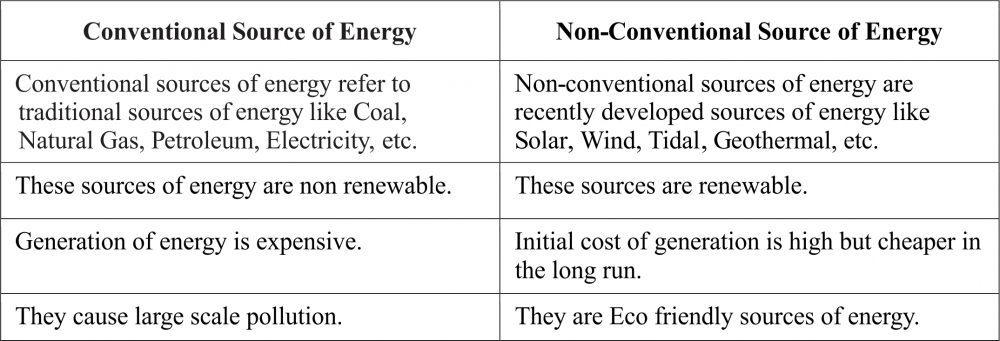
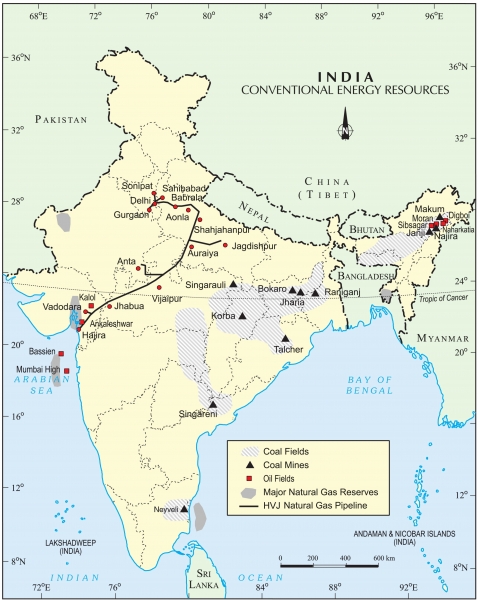
1. COAL:
• Coal is the most abundantly available fossil fuel in India.
• India is highly dependent on coal for meeting its commercial energy requirements.
• Depending on the degree of compression, depth and time of burial, there are different varieties of coal:
(a) Lignite: It is a low grade brown coal. It is soft and has high moisture content. Neyveli in Tamil Nadu has the main reserves of lignite coal. This type of coal is used for electricity generation.
(b) Bituminous Coal: Coal which was formed because of increased temperature and was buried very deep is called bituminous coal. This is the most popular coal for commercial use. High grade bituminous coal is ideal for use in metallurgy.
(c) Anthracite Coal: This is the highest quality hard coal.
• In India, coal occurs in rock series of two main geological ages.
(a) The Gondwana coal was formed over 200 million years ago. The tertiary deposits are about 55 million years old. The major sources of Gondwana coal are located in the Damodar valley (West Bengal-Jharkhan). In this belt; Jharia, Raniganj and Bokaro are important coalfields. Coal deposits are also present in the Godavari, Mahanadi, Son and Wardha valleys.
(b) Tertiary coal is found in the north-eastern states of Meghalaya, Assam, Arunachal Pradesh and Nagaland.
• Coal is a bulky material, which loses weight on use as it is reduced to ash. Hence, heavy industries and thermal power stations are located on or near the coalfields.
2. PETROLEUM
• After coal, petroleum or mineral oil is the next major energy resource in India.
• Petroleum is a major source of fuel for various uses like: heating and lighting, lubricants for machinery and raw materials for a number of manufacturing industries.
• Petroleum refineries act as a "nodal industry" for synthetic textile, fertilizer and numerous chemical industries.
• Petroleum also provides raw materials for various manufacturing industries; like plastic, textiles, pharmaceuticals, etc.
• Most of the petroleum in India occurs in anticlines and fault traps in the rock formations of the tertiary age.
• The oil bearing layer is a porous limestone or sandstone through which oil may flow.
• The intervening non-porous layers prevent the oil from rising or sinking.
• Petroleum is also found in fault traps between porous and non-porous rocks.
• Gas, being lighter usually occurs above the oil.
• Mumbai High produces about 63% of India's petroleum; Gujarat produces 18% and Assam 13%.
• Ankeleshwar is the most important oil field in Gujarat. Assam is the oldest oil producing state of India. Important oil fields of Assam are Digboi, Naharkatiya and Moran-Hugrijan.
3. NATURAL GAS
• Natural gas is an important clean energy resource found along with or without petroleum.
• Natural gas is considered an environment friendly fuel because of low carbon dioxide emissions and is, therefore, the fuel for the present century.
• It is used as fuel and also as an industrial raw material.
• Large reserves of natural gas have been discovered in the Krishna-Godavari Basin. Gulf of Cambay, Mumbai High and Andaman Nicobar islands are also important areas with large reserves of natural gas.
• The 1700 km long Hazira-Vijaipur-Jagdishpur pipeline links Mumbai High and Bassein with the fertiliser, power and industrial complexes in western and northern India.
• Natural gas is mainly used by the fertiliser and power industries.
• Now-a-days, use of CNG (Compressed Natural Gas) is increasing as vehicle fuel in the country.
4. ELECTRICITY
• Electricity is generated mainly by two methods:
(a) Hydo Electricity: By running water which drives hydro turbines to generate Hydro Electricity.
(b) Thermal Electricity: By burning other fuels like coal, petroleum and natural gas to drive turbines to generate Thermal Electricity.

NON-CONVENTIONAL SOURCES OF ENERGY
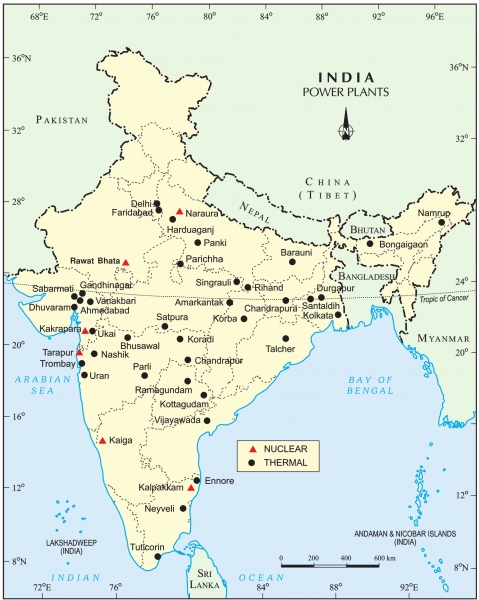
1. NUCLEAR ENERGY
• Nuclear energy is obtained by altering the structure of atoms.
• When the structure of an atom is altered, too much energy is released in the form of heat. This heat is utilized to generate electric power.
• Uranium and Thorium are used for generating atomic power.
• These minerals are available in Jharkhand and the Aravalli ranges of Rajasthan.
• The Monazite sand of Kerala is also rich in Thorium.
2. SOLAR ENERGY
• Photovoltaic technology is used to convert solar energy into electricity.
• The largest solar plant of India is located at Madhapur near Bhuj.
• Solar energy holds great promises for the future.
• It can help in minimizing the dependence on firewood and animal dung cakes in rural areas.
• This will also help in conservation of fossil fuels.
3. WIND POWER
• India has great potential of wind power.
• The wind farm cluster in Tamil Nadu (from Nagarcoil to Madurai) is the largest cluster in India.
• Andhra Pradesh, Karnataka, Gujarat, Kerala, Maharashtra and Lakshadweep are also important centres of wind power production.
• Nagarcoil and Jaisalmer are well known for effective use of wind energy in the country.
4. BIOGAS
• Biogas can be produced from shrubs, farm waste, animal and human waste.
• Decomposition of organic matter yields gas, which has higher thermal efficiency in comparison to kerosene, dung cake and charcoal.
• Biogas plants can be set up at municipal, cooperative and individual levels.
• The biogas plants using cattle dung are known as 'Gobar Gas Plants' in rural India.
• These plants provide twin benefits to the farmer:
(a) In the form of energy
(b) Improved quality of manure.
• It also prevents the loss of trees and manure due to burning of fuel wood and cow dung cakes.
5. TIDAL ENERGY
• Oceanic tides can be used to generate electricity.
• Floodgate dams are built across inlets.
• The water flows into the inlet during high tide and gets trapped when the gate is closed. Once the tide recedes, the gates are opened so that water can flow back to the sea. The flow of water is used to run the turbine to generate electricity.
• In India the Gulf of Khambhat, the Gulf of Kuchchh in Gujarat on the western coast and the Gangetic delta in Sunderban regions of West Bengal provide ideal conditions for utilizing tidal energy.
6. GEO THERMAL ENERGY
• Geo thermal energy refers to the heat and electricity produced by using the heat from the interior of the Earth.
• We know as we go deeper and deeper in the earth it become hotter and hotter.
• Where the geothermal gradient is high, high temperatures are found at shallow depths. Groundwater in such areas absorbs heat from the rocks and becomes hot. It is so hot that when it rises to the earth's surface, it turns into steam. This steam is used to drive turbines and generate electricity.
• Two experimental projects have been set up in India to harness geothermal energy. They are; the Parvati Valley near Manikarn in Himachal Pradesh and the Puga Valley in Ladakh.
CONSERVATION OF ENERGY RESOURCES
• Energy is a basic requirement for economic development.
• Every sector of the national economy: agriculture, industry, transport, commercial and domestic needs energy. As a result, consumption of energy in all forms has been steadily rising all over the country.
• There is an urgent need to develop a sustainable path of energy development.
• India is presently one of the least energy efficient countries in the world.
• We have to adopt a cautious approach for the judicious use of our limited energy resources.
Different ways of conserving power resources are:
(a) We can make use of energy efficient equipments.
(b) Looking for alternative sources of energy.
(c) Use of public transportation system instead of private vehicles.
(d) Switching off electricity when not required.
(e) Making people aware about the importance and conservation of power resources. Etc.
-----x-----X-----x-----
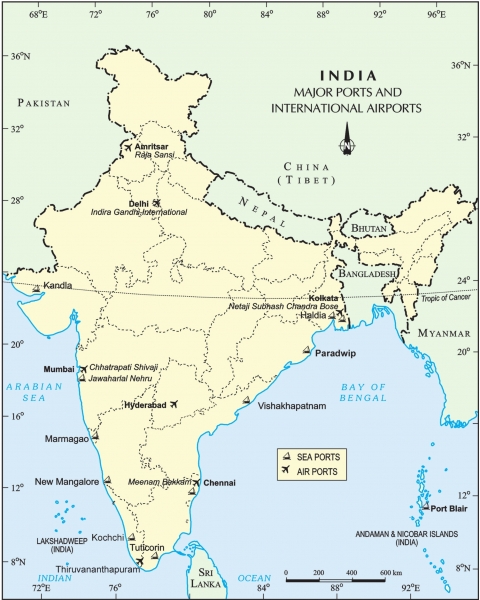


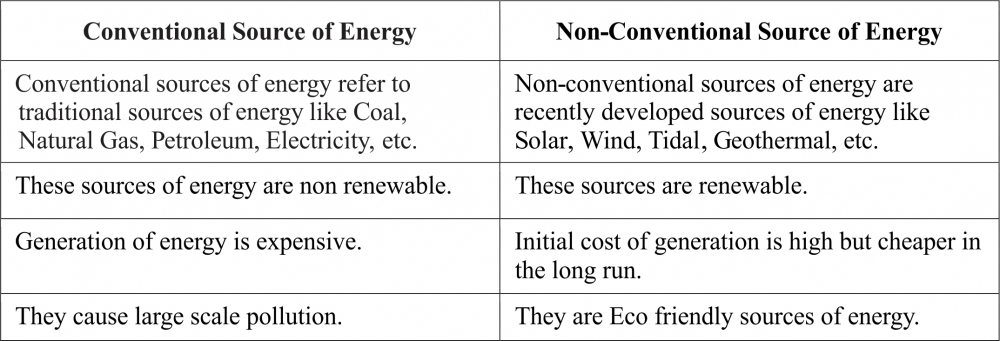
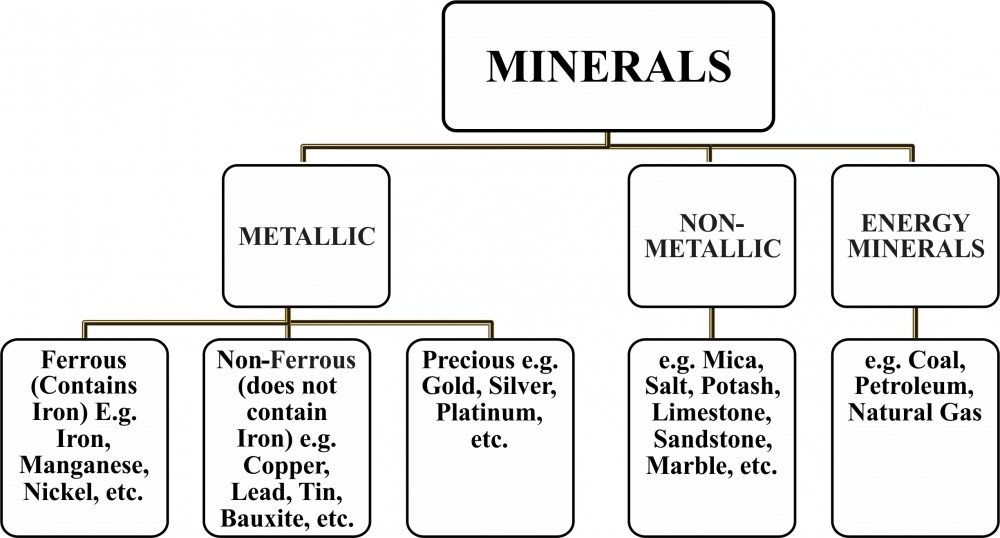
_0_o.jpg)













